Big, lumbering, and dinosaur-like, tortoises are among the most fascinating species in the world, so we wouldn’t blame you if you had a million questions about them!
In today’s article, we’ll be answering one question in particular: What do tortoises eat?
Do these reptiles hunt their food? How can they chase after prey when they’re so heavy and slow? Do they eat plant material only?
Before answering these questions and more, let’s get to know this amazing animal a little better!
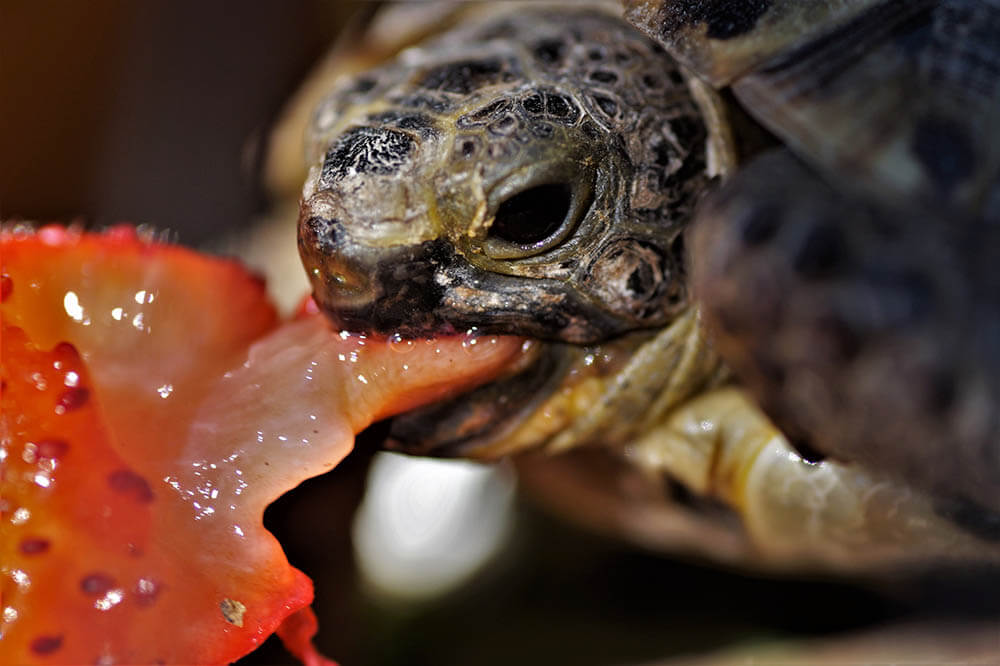
Introducing… the Tortoise!
Tortoises are a type of turtle and therefore a kind of reptile. They’re known for distinctive anatomical features such as a body encased in a rounded, domed, bony shell; club-like forelegs and column-like, “elephantine” hind legs; and feet that lack flippers or webbed digits. Tortoises also tend to be larger and heavier than turtles.
Unlike turtles, tortoises live exclusively on land. They can be found in a broad array of habitats, including wet tropical forests and deserts.
While most tortoises only eat plants, some eat meat, as well. Which brings us to…
What Do Tortoises Eat in the Wild?
Tortoises mostly rely on their sense of smell when searching for something to fill their belly. They also have good eyesight as well as night vision, allowing them to spot edibles even after the sun has gone down. As these reptiles are diurnal, however, they’re usually up and about during the day, though they can also be active in the early evening and the wee hours of the morning.
Because tortoises move slowly (with many of them unable to reach speeds of 1 mile per hour), they end up spending an inordinate amount of time foraging for food. Fortunately, a lot of what they eat can be easily found within their natural habitat, with these creatures often locating food no more than a couple of hundred feet away from their burrow.
The wild tortoise diet
Most tortoise species are herbivores; in their natural habitat, they only feed on plants and fungi such as vegetables, grass, leaves, and mushrooms. However, some species are omnivorous, consuming vegetation and meat alike.
With that in mind, let’s go over the foods wild tortoises commonly eat!
Plants and fungi
- Alfalfa grass
- Aloe
- Apples
- Barley
- Bermuda grass
- Clover
- Grains
- Hay
- Hibiscus leaves
- Melons
- Mulberry leaves
- Mushrooms
- Pears
- Sowthistle grass
In general, omnivorous tortoises prefer plant matter; they’ll actively look for vegetables, fruits, leaves, and grass to eat.
Animals
- Carrion
- Earthworms
- Insects
- Millipedes
- Snails
- Slugs
When it comes to eating meat, omnivorous tortoises tend to be opportunistic – they don’t actively hunt prey. Instead, they only devour prey they happen to come across during the process of looking for plants to snack on.
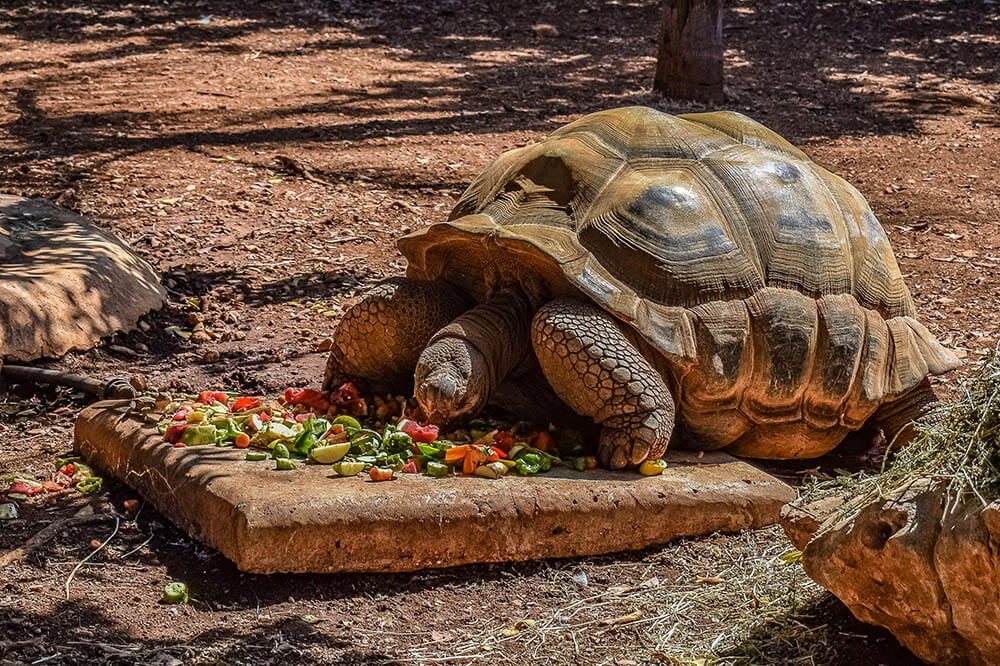
How geographic location affects the wild tortoise diet
Tortoises are land-dwelling reptiles that inhabit many parts of the world, including North and South America, the Mediterranean basin, sub-Saharan Africa, Eurasia, Southeast Asia, several Pacific islands, and Madagascar.
As different places around the world are home to distinct species of plants, fungi, and animals, where a tortoise lives determines what it typically dines on.
Below, we’ve listed some examples of various tortoise species, and how their natural habitat influences their diet.
Arid tropical regions
Tropical regions, especially those with a dry climate, offer tortoises fewer food options. The tortoises found in such places include:
Indian Star Tortoise: found in India, Sri Lanka, and Pakistan, these creatures live in semi-desert grasslands, scrub forests, and humid jungles.
Leopard Tortoises: these creatures call the semi-arid areas and dry savannahs of Southern and Central Africa home.
Sulcata a.k.a. African Spurred Tortoise: native to Northern Africa’s deserts and grasslands, these reptiles burrow underground to escape high temperatures.
These animals normally graze on grass, flowers, leaves, stems, cacti, and weeds.
Tropical jungle regions
Tortoises that inhabit the dense rainforests of the tropics enjoy a wide range of vegetation. Such tortoises include:
Burmese Mountain Tortoise: these are located in countries such as Thailand, Sumatra, Myanmar, and Malaysia. They burrow under the soil and prefer cool and moist weather.
Elongated Tortoise: these inhabit many locations, such as Bangladesh, Cambodia, Laos, Malaysia, Myanmar, Nepal, Southern China, and Vietnam. They live in highly humid tropical forests, where they like taking advantage of the cover the local flora offers.
Red-Footed Tortoise: making their home in Argentina, Panama, and South America, these reptiles live in savannahs, grasslands, and wet and dry forests alike.
Yellow-Footed Tortoise: found in the humid jungles of Bolivia, Brazil, Ecuador, French Guiana, Guyana, Peru, Southern Columbia, and Venezuela, these animals prefer staying among the undergrowth.
The tortoises listed above usually enjoy a diet consisting of flowers, fruits, grass, leaves, and fungi. Occasionally, they also consume invertebrates and amphibians.
Mediterranean regions
Many tortoise species inhabit the arid areas around the Mediterranean. Examples of such tortoises include:
Hermann’s Tortoise: found in the areas surrounding Southern Europe, these creatures live in evergreen and oak forests, rocky slopes, and verdant hillsides.
Marginated Tortoise: these call the dry scrub, hillsides, and woodlands of Greece and Southern Italy home.
Spur-Thighed Tortoise a.k.a. Greek Tortoise: these reptiles live in the semi-arid grasslands of Southwest Asia, Southern Europe, and North Africa.
Russian Tortoise: these reptiles live in the rocky deserts of Afghanistan, Iran, Pakistan, and Russia.
Typically, these animals live in semi-arid grasslands, which offer them plenty of shrubs, succulents, and weeds to eat.
Mediterranean tortoises often make the most popular pet tortoises.
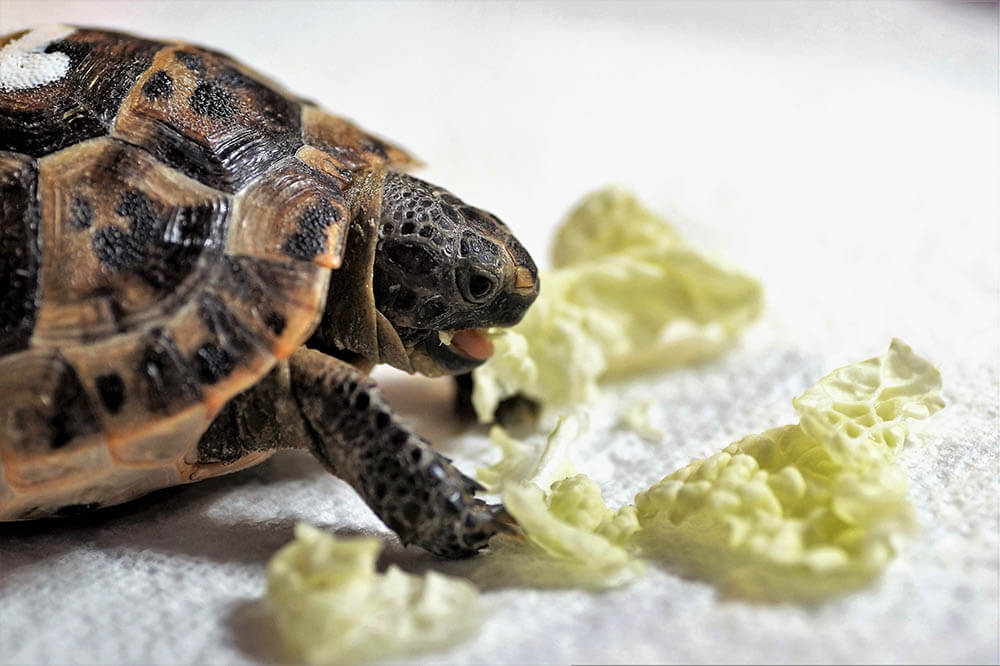
What Do Tortoises in Captivity Eat?
A pet tortoise should be fed foods that its wild counterpart would eat. However, as it’s not possible to offer a tortoise in captivity an exact replication of its natural diet, your best bet is to feed it a close approximation of said natural diet.
Many foods you can give to your pet can be purchased at supermarkets. Others are available at reputable exotic pet stores. You can even give your pet commercial tortoise food.
Before choosing what to include in your pet’s diet, make sure to consult a veterinarian specializing in tortoise care, as they can examine your reptilian friend and determine what edibles it can benefit from the most.
Common foods to feed a pet tortoise
Here are some of the best nutrient-rich foods you can feed a pet tortoise.
- Artichokes
- Bell peppers
- Clovers
- Collard greens
- Commercial tortoise food
- Dandelions
- Earthworms
- Grapes
- Kale
- Mangoes
- Mulberry leaves
- Peaches
- Squash
- Strawberries
- Sweet potatoes
Generally speaking, pet tortoises prefer leafy green veggies, though they also enjoy other types of vegetables as well as fruits and the occasional meat.
It’s best for a pet tortoise to eat organic food. Foods that are grown non-organically often contain chemicals that can cause illness. At any rate, wash food thoroughly before feeding it to your pet, as this will remove any potentially harmful debris or chemicals coating its surface.
Also, never feed your pet tortoise any creature you’ve caught in the wild or your yard. Such creatures may be contaminated with diseases or chemicals that can harm your pet.
Give your pet a varied, nutritious, yet balanced diet; this will ensure it absorbs a rich assortment of essential nutrients.
Offer it vitamin and mineral supplements as well to further boost its health. Calcium and vitamin D are particularly important, as they help develop and maintain the strength and health of a tortoise’s bones and shell.
Don’t forget to give your pet water! Fill a clean, shallow water dish with fresh water every day. Filter water is ideal as it’s far less likely to contain the chlorine and metals often present in tap water.
And remember to seek veterinary advice to help you determine the best consumables for your pet!
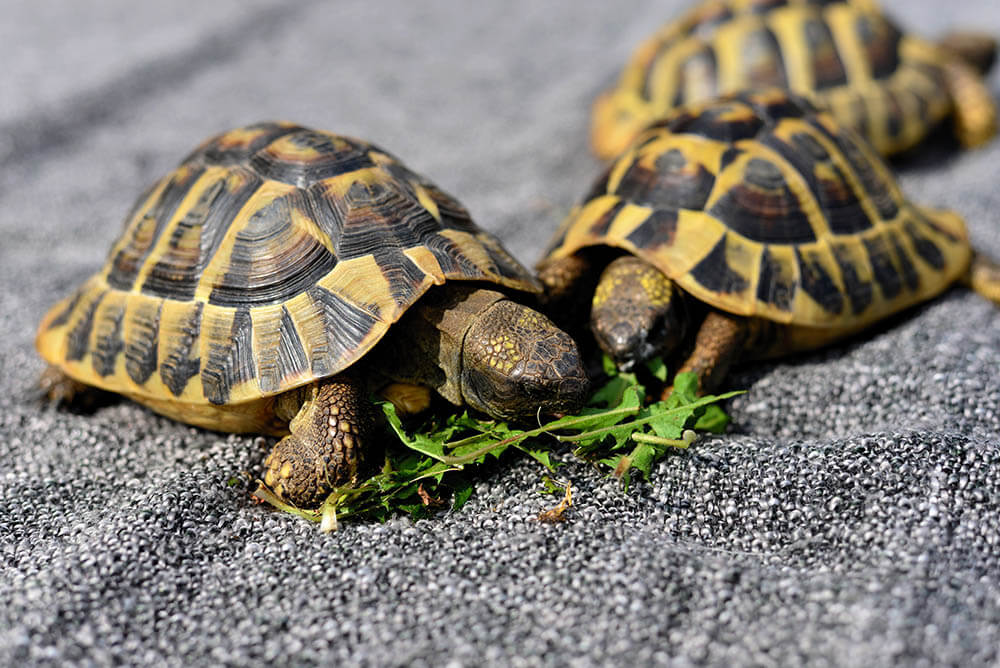
Specific foods to feed a pet tortoise
As discussed above, different tortoise species consume different foods. Therefore, your pet’s species will determine the best foods you should feed it.
Mediterranean tortoises
80% of the Mediterranean tortoise’s diet should be composed of leafy greens.
These animals enjoy salad greens. Just make sure not to give them veggies such as iceberg lettuce, as these are low in nutrients.
In addition to the previously suggested common tortoise foods, you can feed your Mediterranean reptile the following weeds:
- Chicory
- Coleus
- Clover
- Dandelion
- Field bindweed
- Hawkbit
- Hedge mustard
- Mallow
- Plantain
- Shepherd’s purse
- Sowthistle
- Vetch
Don’t feed your pet any plants that are coated with chemicals such as pesticides, as these can make your pet ill.
Your pet’s regular diet can also consist of succulents and flowers. You can even feed it vegetables including broccoli, butternut squash, cauliflower, and peppers up to two times a week.
A Mediterranean tortoise can also ingest the following fruits:
- Cherries
- Grapes
- Mangoes
- Melons
- Peaches
- Pears
- Strawberries
As too many fruits can upset your pet’s sensitive digestive system, fruits should be given sparingly – like once every couple of weeks.
Tropical jungle tortoises
Is your pet a tropical jungle tortoise? Then make sure its diet is 80% leafy green veggies such as those a Mediterranean tortoise would consume. Up to two times a week, you can also feed it veggies like cauliflowers and broccoli as well as fruits.
Many such tortoises occasionally feed on meat. Therefore, once per week, you can also offer your reptilian pal a tiny amount of protein including:
- Canned fish
- Cooked chicken
- Dog food
- Earthworms
When preparing these protein-rich foods for your pet, make sure you don’t add any unnecessary ingredients (such as salt, sugar, oil, dairy, herbs, and spices), as these can harm its health.
Arid tropical tortoises
Pet tortoises originally hailing from the savannahs and grasslands of arid tropical regions enjoy eating grass. Therefore, they’ll be happy munching on the grass on your lawn or in your backyard, though around 80% of their diet should still consist of various leafy greens, such as those you can feed a Mediterranean tortoise.
If your pet is an Indian Star Tortoise, feed it protein in small amounts, so serve it a few pieces of meat such as fish once per week.
Foods not to feed a pet tortoise
Some foods aren’t safe for tortoises to eat.
While these animals tend to avoid eating plants that can harm them, it’s still a good idea to familiarize yourself with the foods that are potentially dangerous for them. To help you out, here are some of the plants you should never offer your pet:
- Auriculas
- Avocados
- Azaleas
- Bean sprouts
- Buttercups
- Citrus fruits
- Daffodils
- Foxgloves
- Hydrangeas
- Irises
- Morning glories
- Wood anemones
How much a pet tortoise eats
Depending on its species, you should feed your pet 3 to 5 times a week. Those days without food will help its digestive system process the food in its belly.
Per feeding session, give your pet an amount of food around the size of its shell. This food should be a combination of vegetables, fruits, protein sources, and commercial tortoise foods, with leafy greens making up at least 80% of each meal.
If you have a yard that’s lush with vegetation, however, you can simply let your pet graze outside, then serve it small portions of nutritious foods every couple of days.
Consult a veterinarian whose focus is on tortoises to determine the right amount of food to feed your pet per week.
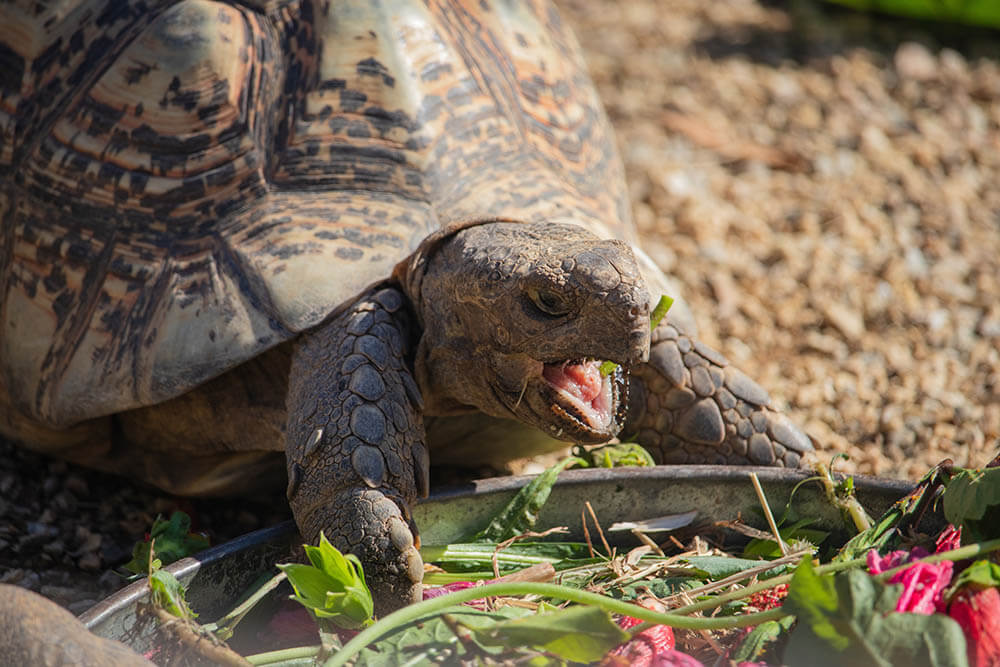
Conclusion
What does a tortoise eat? It depends on its species and where it comes from.
In general, tortoises are herbivores, enjoying plant matter such as vegetables and fruits. Some species, however, eat meat on occasion.
If you have a pet tortoise, you should feed it a diet consisting primarily of leafy greens. You can also give it other types of veggies less frequently and fruits as a rare treat. If your pet’s species is an omnivore, serve it protein-rich foods such as invertebrates and cooked chicken.
Don’t forget to seek help from a veterinarian when choosing which foods to feed your pet!
